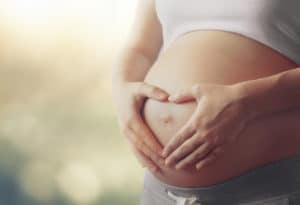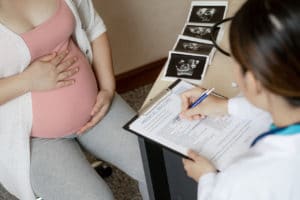A baby that cries all the time can be a very big burden – especially at night through the baby monitor. If you do not know what is wrong with your baby, it is best to go to the doctor. Maybe the pediatrician will diagnose KISS syndrome, which is considered the most common cause of pronounced crying. However, it can be corrected in a very short time.
The term KISS syndrome was introduced back in 1991 by the surgeon Dr. Heiner Biedermann. KISS- syndrome is the abbreviation for upper cervical joint-induced symmetry disorder. Strictly speaking, it is not a disease, but a control disorder. KISS syndrome is a malposition that originates from the transitional area between the base of the skull and the vertebral joints in the upper cervical spine. Asymmetrical postures and movements occur due to KISS syndrome. It leads to hyperextension of the spine, facial asymmetry, different sized halves of the face, as well as asymmetric use of the arms and/or legs.
There are two different types of KISS syndrome. KISS I and KISS II.
KISS I
In KISS I, a symmetry disorder occurs through the upper cervical joint because the upper cervical joint and cervical vertebrae have shifted in such a way that your baby has problems turning or tilting its head. He or she will adopt a gentle posture.
KISS II
In KISS II, the upper cervical joint and cervical vertebrae are displaced in the same way as in KISS I, but here they are also blocked. The blockage causes your baby to hyperextend his head backwards. When crying, the trachea can narrow and a life-threatening lack of oxygen can occur.
The symptoms of both types are very similar.
Table of contents
Causes
The main cause of KISS syndrome occurs at birth. KISS syndrome can be caused by too much pressure on the head. But KISS syndrome can also be caused by twisting movements that put too much pressure on the baby’s upper cervical joint during birth.
There are some risk factors that can trigger the syndrome. For example, a suction cup or forceps birth, emergency cesarean sections, twin births, very rapid births, and a birth weight greater than 4,000 grams.
Symptoms In Babies
Babies with KISS syndrome avoid the prone position and are reluctant to crawl. Crookedness of the head and trunk and also, if necessary, a distinctly asymmetrical skull shape with flattened back of the head can also be signs of KISS syndrome. However, since every child reacts differently to pain, small signs can often be of help in correctly assessing the situation.
Classic Symptoms In Infants
- A tilted position in bed and an asymmetrical head posture.
- Drinking problem with difficulty in swallowing and frequent drooling.
- Frequent waking and restlessness – Sleep disturbances.
- Sensitivity to touch, especially when lifting ( babies often react by crying or screaming ).
- Head turning weakness and head holding weakness.
- Three-month colic, crying babies.
- Skull/head asymmetry with unilateral underdevelopment of one half of the face.
These symptoms can also be consequences of other causes. In the case of a KISS syndrome, all symptoms do not necessarily have to occur at the same time.
Symptoms In Children And Adults
KISS syndrome is blamed for many other complaints in children. These complaints include impaired motor development, failure to thrive with decreased growth and failure to gain weight, and ENT problems.
If KISS syndrome in infants is not treated, the so-called KIDD syndrome occurs. KIDD syndrome means upper cervical-induced dyspraxia/dysgnosia. Dyspraxia means that the affected children are not able to correctly execute learned movements despite existing perceptual and movement abilities.
Dysgnosia means that the baby has impaired perception.
In school-age children, the syndrome leads to learning difficulties such as poor concentration, hyperactivity or aggressiveness. Arithmetic weakness is also mentioned as a consequence. In addition, there are headaches and postural weaknesses.
In an adult, untreated KISS syndrome can lead to cervical spine problems, chronic back pain, herniated discs, ringing in the ears, dizziness, balance and movement disorders.
Treatment Of KISS Syndrome
The doctor will probably advise an X-ray, as comprehensive examinations are needed before treating KiSS syndrome. On the one hand, the therapists check various classic reflexes, but also take a look at the shape of the head as well as conspicuous postures, muscle tension and, of course, age-appropriate development. They also check whether the child can turn his or her head to all sides without any problems.
There are several treatment approaches that are listed here for you.
Atlas Therapy According To Arlen: This method mainly treats the first cervical vertebra, also called the atlas. The atlas is directly connected to the skull. The therapist places his fingers on the lateral processes of the first cervical vertebra and applies a rapid pressure impulse in the direction of the atlas.
Haio: In this method, a much more violent and short impulse is applied to the transverse process of the atlas. The KISS syndrome should be eliminated with this method in a few minutes in one or two sessions.
Treatment According To Biedermann/Gutmann: This therapy involves the joints between the base of the skull and the first cervical vertebrae. With this method, the pressure impulse can be applied to both sides, upwards and downwards.











1 thought on “KISS Syndrome”